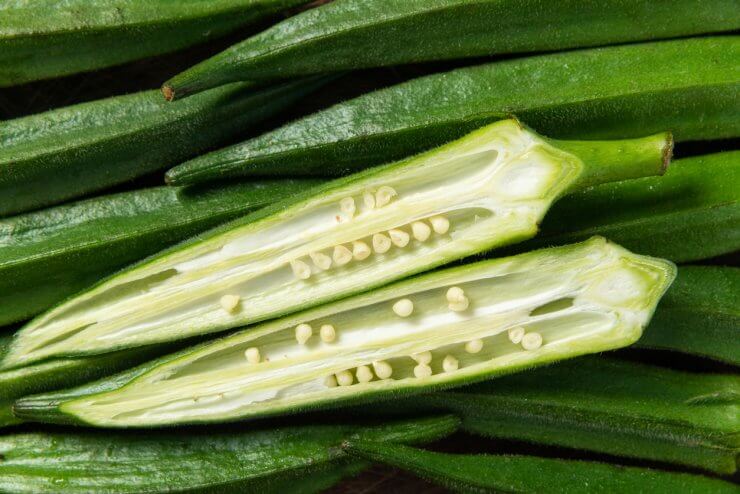
Inside a piece of okra
All okra are what we call day-neutral. Their growth is not dependent on the length of the day in order to bloom and grow. So whichever USDA Hardiness Zone you’re in, you’re in luck. You can find a way to grow okra! They do still need a good six to eight hours of sunlight a day, so pick your planting spot accordingly.
Not all okra look or grow quite the same. Here’s a look at the different types you can consider.
Heirloom Okra
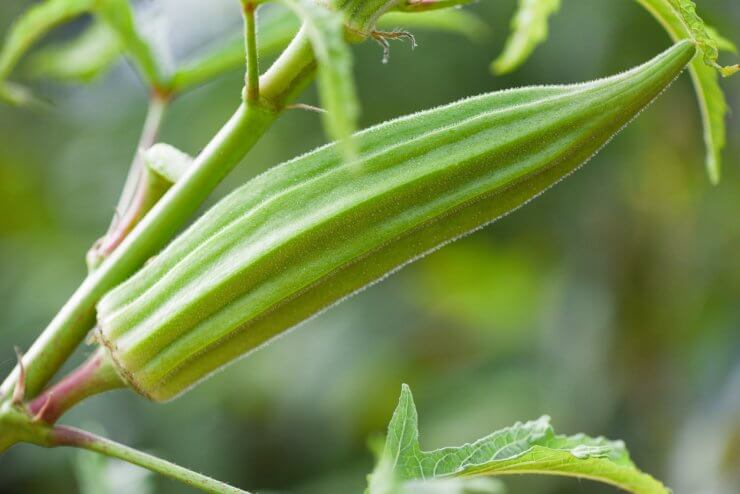
Heirloom Okra
Heirloom okra bring the past to life. These plants, from a century ago or longer, have long, narrow pods, hard ribs along the pods, and a sharp point at the tip of the seed pod. To make things more interesting, the pods have thorny spines around the base. Some heirlooms are a labor of love: miss the harvest window and you’re left with tough, prickly seed pods. That being said, heirloom okra are self-pollinating and will reproduce true to seed. So if you let some pods ripen past their eating window, you can save the seed pods, dry them, and use the seeds for your next planting.
Heirloom okra include:
- Silver Queen: This variety grows to 6 feet tall with pods up to 7 inches long.
- Cow Horn: This type grows up to 8 feet tall with pods up to 14 inches long. Harvest them at 7 inches or less, or plan to use the full-size pods in dried floral arrangements.
Spineless Okra
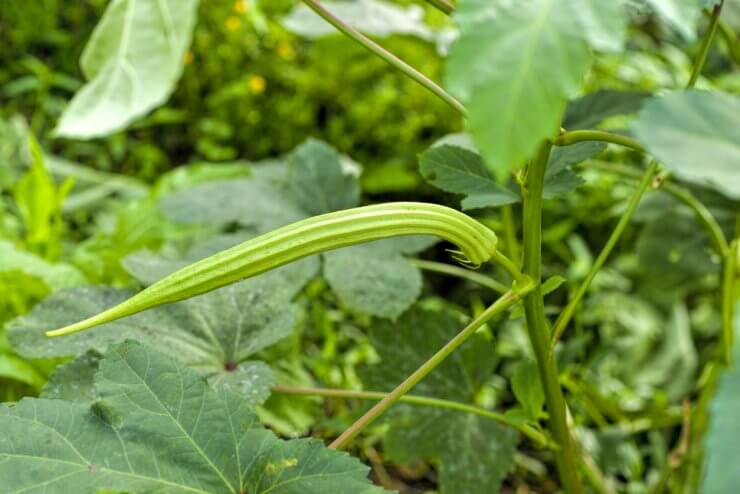
A variety of spineless okra
Okra with spineless pods make harvesting oh-so much easier. Over time, plant breeders have managed to eliminate the spines that could make picking pods a painful process. In addition to breeding out the spines, growers bred in more tenderness to the pods and kept the familiar deep grooves.
Spineless okra include:
- Clemson Spineless: This variety was developed at—yup—Clemson University in 1939. It gained top honors from the All-America Selections (AAS). A lovely plant, the Clemson Spineless grows to be about 5 feet tall with uniform pods. Be sure to pick them before they mature, at about 3 inches long.
- Cajun Delight: This variety is another award-winner that only grows to about 4 feet tall, with 5-inch pods.
Dwarf Okra

A dwarf okra variety
Dwarf okra plants have a reputation for growing back to standard size if given the opportunity, so plan accordingly. In general, dwarf okras grow to just 2 to 4 feet instead of a more typical 4 to 8. You can find both heirloom and modern cultivars, with spines and without. Dwarf okra, as the name implies, can work well in small spaces.
A couple dwarf okra to consider:
- Cajun Jewel: This plant grows 2 1/2 to 4 feet tall and will produce an early crop of spineless pods that can grow as long as 8 inches.
- Dwarf Green Long Pod: This plant tops out at 2 1/2 feet and produces ribbed pods up to 8 inches long.
Giant Okra
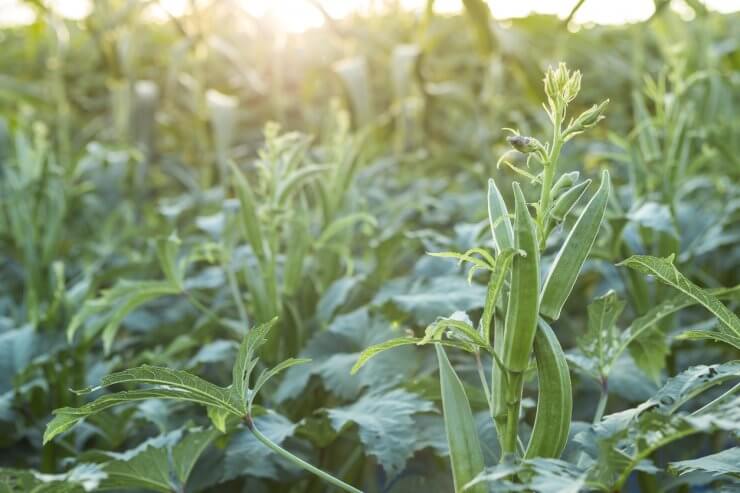
Giant Okra
Giant okras come by their name honestly: some varieties can stretch to 10 feet tall or more—that’s double the height of your average okra plant. And some giant okra plants are average height but produce big, fat pods that make standard okra pods look tiny.
Among giant okra, you will find:
- Beck’s Big Buck: This plant produces big, fat pods that you’ll have trouble wrapping your hand around.
- Perkins Mammoth Long Pod: This plant can grow up to 10 feet tall. If you want to eat the giant pods, harvest them when they’re 4 to 5 inches long. If you want to save them for decoration, they’ll grow to as long as 9 inches.
But wait; there’s more. You may want to choose your okra not for its size but more for its flavor and suitability for certain types of cooking.
Round Pod Okra
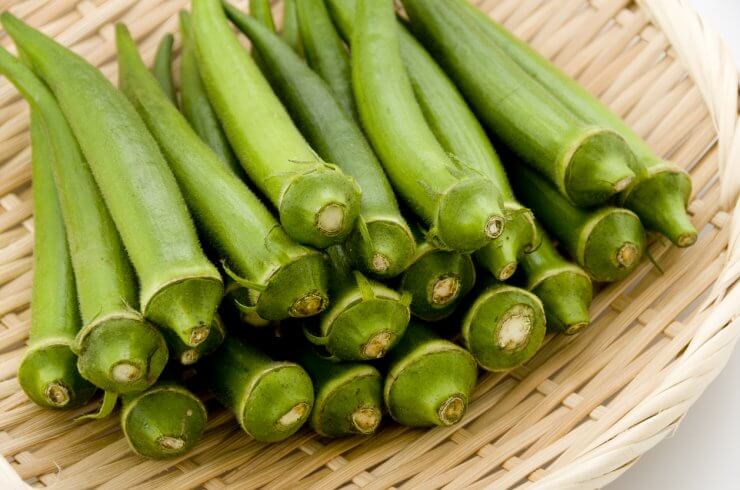
Round pod okra
Round pod okra have smooth skin instead of ribs like we picture most okra to have. The upside of that is that these okra are thicker, which makes them popular for canning.
Round pod okra include:
- Emerald: The Campbell Soup Company developed this cultivar for its famous soups. Emerald will produce early harvests of richly flavored smooth pods, perfect for soup.
- Louisiana Green Velvet: This is an award-winning variety that just flourishes in high heat and humidity. The smooth, 8-inch pods will retain their vivid color when you cook them.
Star Pod Okra
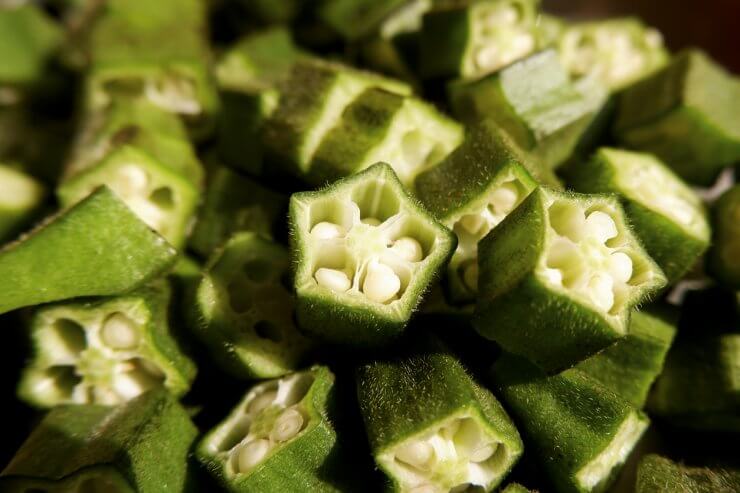
Star pod okra
Star pod okra have five to eight ribs running the length of the pod, giving them a scalloped or fluted appearance. When you cut them crosswise, the pod slices have a beautiful star shape that adds a lovely touch to whatever you’re cooking.
Star pod okra include:
- Star of David: These pods look like the classic six-pointed star when you cut them crosswise. The pods have a rich flavor, and they grow 5 to 7 inches long on plants that can reach 10 feet tall.
- Annie Oakley II: This plant stays short and compact, producing an abundant harvest of long, spineless pods.
Red Okra

Red okra
Most okra are some shade of green. But some varieties have red or purple pods, and even the stems and leaf veins can take on a red hue. Fair warning: when you cook red okra, you get green okra. Red okra will hold its color as long as you don’t cook it.
Red okra to review:
- Red Burgundy: This plant only grows to be about 3 or 4 feet tall, but it produces a prolific harvest of purple-red pods about 6 inches long.
- Red Velvet: This plant grows to about 4 or 5 feet tall, with bright red, slightly ribbed pods ranging from 3 to 6 inches, growing on bright red stems. This plant is as lovely to look at as it is to eat.
Which type of okra have you grown? Do you have a preference? Please share your opinion by commenting below.


 Previous
Previous


My local vegetable store has okra. I’ve watched people pick over the pods and leave with bags of them. I finally tried Okra for the first time the other day. I asked one person who was picking up Okra pods how to decide which ones were best. He showed me to choose ones that were slightly soft. He told me how to cook them. I got a lot of advice from people who were standing in line with me to buy my groceries. I tried washing them. I cut off each end. Then I slit them longways and then drizzled them with olive oil and garlic powder. Another person suggested that I cut them up and mix with onion and spices and then cook them. This was a South Asian vegetable store and I found everyone who knew this was the first time for me to try Okra, were so helpful. I have a shady back yard. So I am not sure I would be successful trying to grow Okra. But I am game to try and eat it in the future.
Very interested I like okra how can I get some seeds to purchase for my garden
Coleen – I’m so glad you want to try growing okra. Please check out the Resources section of this collection for some links to great companies that sell okra seeds.
https://foodgardening.mequoda.com/resources/resources-about-okra/?t=9150
You might also enjoy this article on 2022 seed catalogs.
https://foodgardening.mequoda.com/daily/vegetable-gardening/free-seed-catalogs-for-veggie-gardeners/